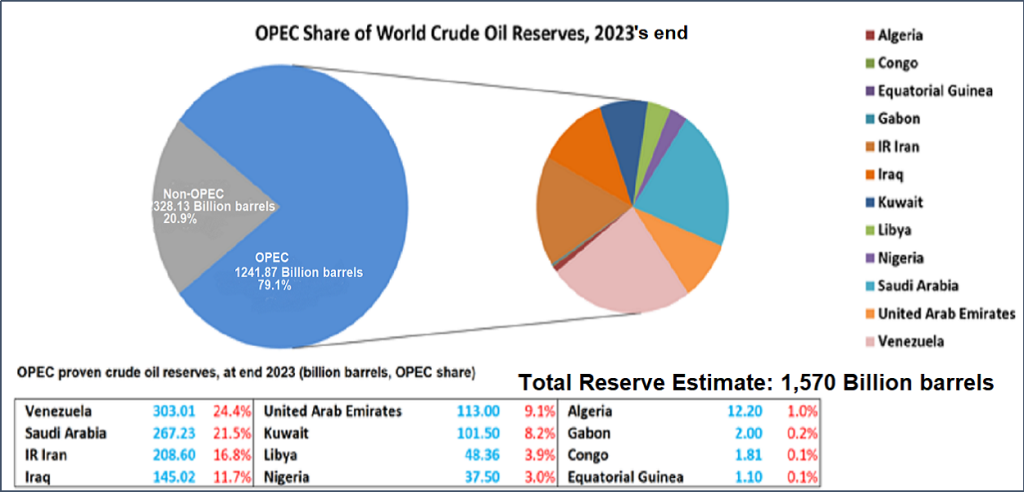The Creation of Kerogen— Petroleum’s Source

Kerogen consists of a variety of organic materials, including dead plants, algae, and other microorganisms, that have been compressed and heated by geological processes. It is defined as hydrocarbons that are insoluble in normal solvents that yield liquid or gaseous petroleum when heated.
In short, kerogen amounts to fossilized organic matter that has been buried and subjected to high temperatures and pressures over millions of years, resulting in various chemical reactions and transformations that created Crude Oil and Natural Gas.
Kerogen is believed to be the most abundant source of organic compounds on earth, exceeding the total organic content of living matter by 10,000-fold. So how much is 10,000 fold of all living matter?
It is believed prior to Crude Oil extraction, there were 550 gigatons (1 gigaton = 1,000,000,000 matric tons) of biomass carbon on Earth, sooo, 10,000 x 550 gigatons would account for 10,000 fold.
At 2022’s end, the United States had about 65 billion barrels of crude oil in proven reserves.
In 2023, oil production in the United States reached 4.3 billion barrels.
In 2024, oil production in the United States reached 4.6 billion barrels; establishing an average of 4.45 Billion Barrels per year.
At 2024’s end, the United States had 55.25 billion barrels of proven crude oil reserves according to World Atlas, a leading petroleum industry publication with worldwide coverage. 55.25 ÷ 4.45 = 12.42 years of proven US oil reserves remaining!
At 2024’s end, the World had 1,730 billion barrels of crude oil in proven reserves, according to the Oil & Gas Journal who has a primary function to present a comprehensive overview of global crude oil reserves with headquarters in Tulsa, Oklahoma.
And because the world uses approximately 35 Billion barrels of crude oil each year, the globe can maintain it’s addiction to crude oil for several more decades. Though, you can expect some variation to this computation: 1730 ÷ 35 = 49.4 years of proven reserves as we go into year 2025.
Point being, when considering the aforementioned reserve estimate the US Crude Oil reserve will be totally depleted in less than 13 years; meaning the US will be entirely dependent upon the remaining oil producing nations for its crude oil needs of about 20.25 million barrels a day which totals around 7.39 Billion barrels every year for nearly 37 (36.98) years. Then, alas, everyone will be without oil and likely most of these products that just happen to be made with Crude oil: Ink, Floor Wax, Ballpoint Pens, Football Cleats, Sweaters, Insecticides, Bicycle Tires, Nail Polish, Fishing lures, Dresses, Golf Bags, Perfumes, Shoe Polish, Motorcycle Helmets, Caulking, Petroleum Jelly, Transparent Tape and dozens more!
On the other hand, OPEC had a somewhat “dimmer” view in regard to Crude Oil reserves as is reflected with the Annual Statistical Bulletin (ASB) Report at ‘2023’s end; 2024’s adjusted recovery totals are shown below drawing:

Based upon the 2023 ASB Report above, by 2024’s end the World Reserve Base totaled 1,535 Billion Barrels of recoverable Crude Oil after the estimated recovery total is adjusted for those 35 Billion barrels that were used during 2024. Meaning the global addiction to Crude Oil can only be maintained for a few months shy of 44 years (1535 ÷ 35 = 43.85) when this Reserve Estimate is utilized.
But then the total global recoverable oil reserves stood at 1,624 billion barrels, according to Rystad Energy (an independent energy research company headquartered in Oslo, Norway) on July 1 of 2022. The top 2 producing countries included Saudi Arabia who lead in total recoverable Crude Oil Reserves with 271 billion barrels, and oddly, the US followed with 192 billion barrels (see the World Atlas reserve estimate of 55.25 billion barrels several pages above).
Regardless, by deleting 70 Billion Barrels for 2 years of annual consumption of Crude Oil at 35 Billion barrels per year for year 2023 and 2024, the estimated Crude Oil that’s recoverable for January 2025 forward stood at an estimated 1,524 Billion barrels of Recoverable Crude Oil according to this Reserve Estimate.
Sooo, we have three adjusted Reserve Report Estimates;
1. The Rystad Energy Report: at 1,524 Billion barrels
2. The Annual Statistical Bulletin (ASB) Report: at 1,570 Billion barrels.
3.The Oil & Gas Journal (OGJ): at 1,730 Billion barrels.
And, we no longer wonder why the Biden Administration Strongly Supported EV Stations!
______________________________________________________________________
Can You Imagine That